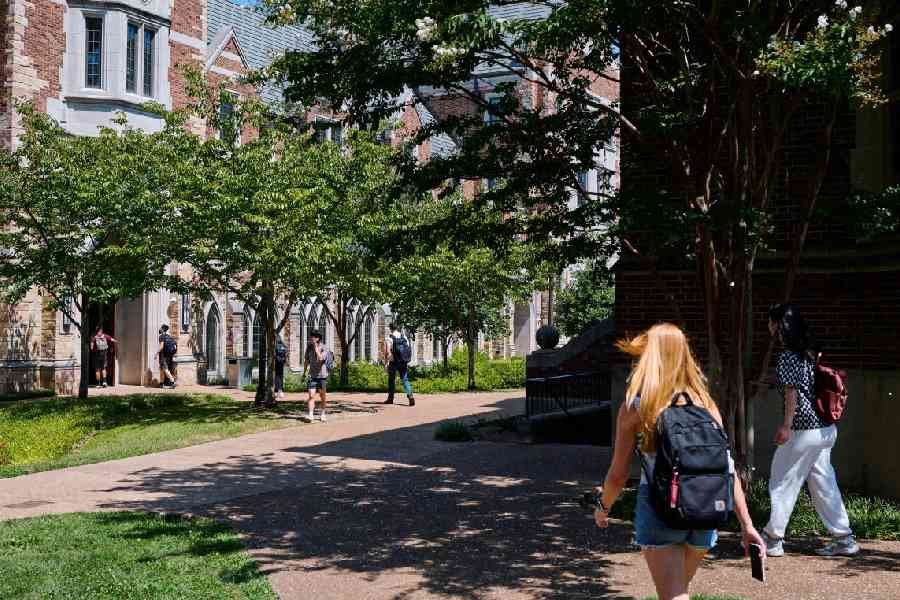Is it worth it?


One letter to a newly admitted Vanderbilt University engineering student showed an all-in price — room, board, personal expenses, a high-octane laptop — of $98,426 (a little more than Rs 82 lakh) per year. A student making three trips home to Los Angeles or London, Ohio, from the Nashville, Tennessee, US, campus during the year could hit six figures.
This eye-popping sum is an anomaly. Only a tiny fraction of students will pay anything close to this anytime soon, and about 35 per cent of Vanderbilt students — those who get neither need-based nor merit aid — pay the full list price.
But a few dozen other colleges and universities that reject the vast majority of applicants will probably arrive at this threshold within a few years. Their willingness to cross it raises two questions for anyone shopping for college: how did this happen? And can it possibly be worth it?
According to the College Board, the average 2023-24 list price for tuition, fees, housing and food was $56,190 (nearly Rs 47 lakh) at private, non-profit four-year schools. At four-year public colleges, in-state students saw an average $24,030 (about Rs 20 lakh) sticker price.
That’s not what many people pay, though, not even close. As of the 2019-20 school year, according to federal data that the College Board used in a 2023 report, 39 per cent of in-state students attending two-year colleges full-time received enough aid to cover all of their fees (but not their living expenses, which can make getting through school enormously difficult). At four-year public schools, 31 per cent paid nothing for tuition while 18 per cent of students at private colleges and universities qualified for the same deal.
Those private colleges conti- nue to provide hefty discounts for people of all sorts of incomes. A National Association of College and University Business Officers study showed private non-profit colleges and universities lowering their tuition prices by 56 per cent from the rack rate during the 2022-23 school year.
Vanderbilt provides discounts, too, and its financial aid is extraordinarily generous. Earlier this year, it announced that families with incomes of $1,50,000 (about Rs 1.25 crore) or less would pay no tuition.
Still, more than 2,000 students there who get no need-based or merit aid will soon pay $1,00,000 or more. Why does Vanderbilt need all of that money?
At a few small liberal arts colleges with enormous endowments, even $1,00,000 (Rs 83.42 lakh)) would not cover the average cost of educating a student, according to the schools. Williams College, US, says it spends roughly $50,000 more per student than its list price.
In other words, everyone is getting a subsidy. Perhaps its list price should be more than $1,00,000 too, so that its endowment is not offering unneeded help to wealthy families. Or, perhaps, a price that high would scare away low-income applicants who do not realise that they might get a free ride there. According to Vanderbilt, its spending per undergraduate is $1,19,000 (around Rs 1 crore).
No one at the school would meet with me to break this figure down or get on the phone to talk about it. But Vanderbilt’s financial statements offer clues to how it spends money. In fiscal year 2023, 52 per cent of its operating expenses went to faculty, staff and student salaries and wages, plus fringe benefits.
Is it worth it?
It depends. Most college shoppers wonder about income outcomes, and it’s possible to search by undergraduate major on the federal government’s College Scorecard website. This programme-level data exists for alumni who are four years out from graduation, though only for those who received any federal financial aid.
Vanderbilt’s biomedical/medical engineering majors have median earnings of $94,340 (nearly Rs 79 lakh) four years out. English language and literature majors are earning $53,767 (nearly Rs 45 lakh).
Those are fine results, but are they exclusive to Vanderbilt? “You could get an engineering degree at a flagship state university that’s just as valuable as something you’d get at Vanderbilt,” said Julian Treves, a financial adviser and college specialist whose newsletter tipped me off to the goings-on there.
Ispent a few days trying to get Vanderbilt’s vice-provost for university enrolment affairs, Douglas Christiansen, to talk to me and answer these questions squarely and more expansively, but I did not succeed.
I attended a group information session for 125 or so pros– pective students and asked there, too. The senior admissions officer who took the question refused to answer.
But really, why should an actor in a competitive marketplace answer that question if they don’t absolutely have to? Without publicly available, industrywide quantitative data on quality — happiness scores, customer satisfaction, measures of learning, return on friendship, the strength of career networks — the list price alone serves as a signal of excellence, to some shoppers at least.
And thousands of applicants respond to the signal each year by volunteering to pay the list price, even as the school rejects the vast majority of applicants. Or maybe they volunteer precisely because Vanderbilt and schools like it reject the vast majority of applicants.
NYTNS